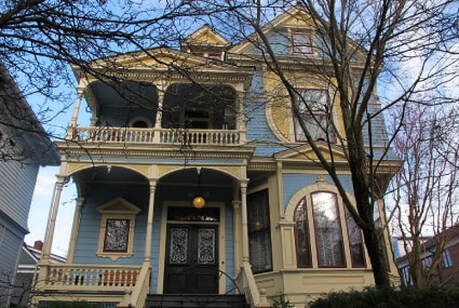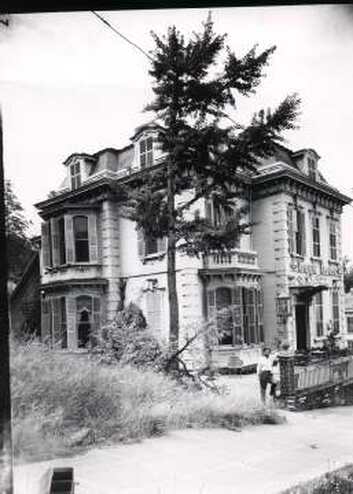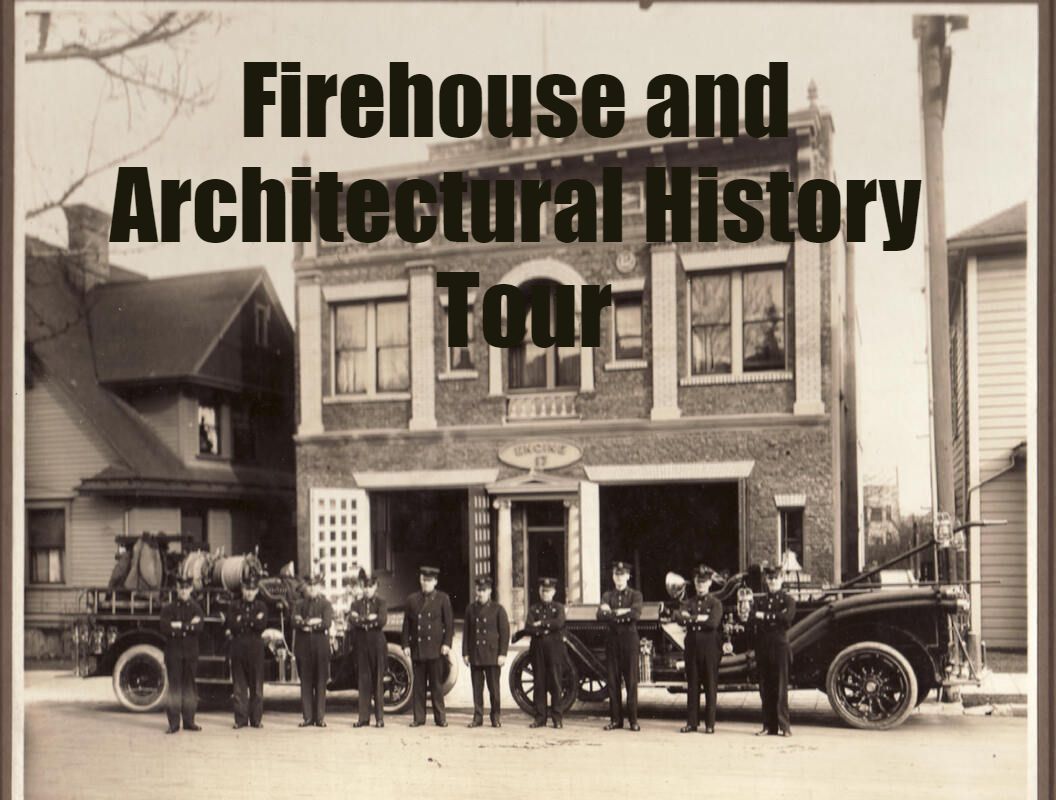Portland Architectural History Tour
* Italic words are defined in the information packet
** All arranged in chronological order
* Stops typically already included in tour
Some on the list below are already included in your tour. You may special request any sight.
Please pre-request your special requests HERE.
* Italic words are defined in the information packet
** All arranged in chronological order
* Stops typically already included in tour
Some on the list below are already included in your tour. You may special request any sight.
Please pre-request your special requests HERE.
Swedish Evangelical Mission Covenant Church/Swedish Tabernacle -erected 1912- (1624 nw Glisan) the church, organized in 1887, erected the building as their permanent home replacing an earlier Gothic-styled structure on the same site. A cross originally surmounted the central parapet. It served as the social and religious center until 1953,when the building, which has a balconied auditorium, became the local longshoreman’s union. And in the late ‘1990s, became the Mcmenamin's Mission Theatre.
Wickersham Apartment Building-erected 1910- (410 nw 18) with its restrained parapet gables, oriel windows and mullioned windows, the structure is in the jacobethan style, as is the Heathman Hotel and the University Club. This handsome building is in near original condition and features four-story galvanized iron bay windows on three facades, and elaborately detailed exterior brickwork.
Trenkmann Houses – 1890-(525 nw 17, 526 nw 18, 1704-1734 nw Hoyt), built as single-family rental units, the eight houses are all of balloon-frame wood construction on brick foundations and exemplify the Queen Anne / Eastlake style.
Campbell Townhouses –1893- (1705-1719 nw Irving and 715-719 nw 17th). Consists of six attached buildings, located in the elite area earlier known as Knob Hill, and are the only example of brick row houses in Oregon. With pairs of projecting bays on each facade, the townhouses exhibit Queen-Anne style detailing. The buildings retain much of their integrity, with virtually no structural modification, all of the original doors, and almost all of the original interior woodwork and moldings.
Couch Family Investment Development –erected 1884-(1721-1735 N.W. Irving) Are four identical Queen Anne’s, which were originally a group of 8 residences, built on this block in the 1880s. They represent an eclectic mixture of Victorian, Queen Anne, and Eastlake styles, and are an early example of tract houses in Portland.
Temple Beth Israel-erected 1926- (1931 nw Flanders) is in the Byzantine style tradition, and is significant as both an architectural and religious landmark. The sandstone, brick and stone structure was designed by noted Portland architect, Herman Brookman. When completed, a Portland newspaper commented “the edifice may be taken as a tribute to Portland art, as well as the foresight of those who planned it.” The congregation was organized in 1858.
Dayton Apt. Building-erected 1907- (2056 nw Flanders) the edifice features an imposing tetra style portico with colossal fluted columns, characteristic of the Colonial Revival style. In addition to the exterior, many of the original interior details, such as the central stairway, steam radiator and beveled and leaded glass panels, remain intact.
Day Building-1907- (2068 nw Flanders) with the extravagant front façade is an apt. building. Its large fluted columns are topped with ornate Corinthian Capitals, making it a striking Colonial Revival building.
Linnea Hall-1909- (2066 nw Irving) the Swedish society Linnea was organized in 1888 and is one of the oldest cultural associations on the west coast. The fraternal lodge is an important landmark to the Swedish heritage in Portland. The building is of an eclectic character, exhibiting features of Scandinavian, Classical, and Baroque styles. The façade is distinguished by a tripartite panel above the entrance, which has two stained-glass windows on either side of a hand-carved Swedish national emblem.
Lewis Mills House-1916- (2039 nw Irving) Boston architect Charles Collidge designed this Colonial Revival style townhouse for noted Oregon lumberman Lewis Mills. The symmetrical house is located in the Nob Hill district. It is in excellent condition and has been well restored. Lewis Mills was Harvard educated and a leader in the lumber industry In Oregon. Upon completion, the house was given to his new bride, Miss Elinor Lewis, as a wedding present.
Wickersham Apartment Building-erected 1910- (410 nw 18) with its restrained parapet gables, oriel windows and mullioned windows, the structure is in the jacobethan style, as is the Heathman Hotel and the University Club. This handsome building is in near original condition and features four-story galvanized iron bay windows on three facades, and elaborately detailed exterior brickwork.
Trenkmann Houses – 1890-(525 nw 17, 526 nw 18, 1704-1734 nw Hoyt), built as single-family rental units, the eight houses are all of balloon-frame wood construction on brick foundations and exemplify the Queen Anne / Eastlake style.
Campbell Townhouses –1893- (1705-1719 nw Irving and 715-719 nw 17th). Consists of six attached buildings, located in the elite area earlier known as Knob Hill, and are the only example of brick row houses in Oregon. With pairs of projecting bays on each facade, the townhouses exhibit Queen-Anne style detailing. The buildings retain much of their integrity, with virtually no structural modification, all of the original doors, and almost all of the original interior woodwork and moldings.
Couch Family Investment Development –erected 1884-(1721-1735 N.W. Irving) Are four identical Queen Anne’s, which were originally a group of 8 residences, built on this block in the 1880s. They represent an eclectic mixture of Victorian, Queen Anne, and Eastlake styles, and are an early example of tract houses in Portland.
Temple Beth Israel-erected 1926- (1931 nw Flanders) is in the Byzantine style tradition, and is significant as both an architectural and religious landmark. The sandstone, brick and stone structure was designed by noted Portland architect, Herman Brookman. When completed, a Portland newspaper commented “the edifice may be taken as a tribute to Portland art, as well as the foresight of those who planned it.” The congregation was organized in 1858.
Dayton Apt. Building-erected 1907- (2056 nw Flanders) the edifice features an imposing tetra style portico with colossal fluted columns, characteristic of the Colonial Revival style. In addition to the exterior, many of the original interior details, such as the central stairway, steam radiator and beveled and leaded glass panels, remain intact.
Day Building-1907- (2068 nw Flanders) with the extravagant front façade is an apt. building. Its large fluted columns are topped with ornate Corinthian Capitals, making it a striking Colonial Revival building.
Linnea Hall-1909- (2066 nw Irving) the Swedish society Linnea was organized in 1888 and is one of the oldest cultural associations on the west coast. The fraternal lodge is an important landmark to the Swedish heritage in Portland. The building is of an eclectic character, exhibiting features of Scandinavian, Classical, and Baroque styles. The façade is distinguished by a tripartite panel above the entrance, which has two stained-glass windows on either side of a hand-carved Swedish national emblem.
Lewis Mills House-1916- (2039 nw Irving) Boston architect Charles Collidge designed this Colonial Revival style townhouse for noted Oregon lumberman Lewis Mills. The symmetrical house is located in the Nob Hill district. It is in excellent condition and has been well restored. Lewis Mills was Harvard educated and a leader in the lumber industry In Oregon. Upon completion, the house was given to his new bride, Miss Elinor Lewis, as a wedding present.
|
The Historic Nathan Loeb House - 1893-(726 N.W. 22nd) This is our tribute to all things Victoriana, all the beautiful painted ladies (yes, San Francisco, Portland has them, too), and to all the good old house lovers who've restored these gems back to glory. We haven't uncovered the architect, but the original owner helped found Temple Beth Israel in NW Portland, and the two separate families, who've labored over the restoration since 1977, deserve architectural accolades.. It's a late 19th century Queen Anne. One of the most ornate in Portland. Features turned wood posts, segmental wood arches with central pendants and sunburst spandrel patterns, and a ground floor projecting slant bay with an ornamental three-bay round arch window. Nathan Loeb was a German emigrant who came to Portland in 1857. He established a general merchandising business, and was a founder of Temple Beth Israel.
|
Mary Smith House-1906- (2256 nw Johnson) this 2 1/2 story is a well-preserved and somewhat unusual example of the ubiquitous Colonial Revival style. It features a central second-story bow window and a full-length veranda with a central bowed portico supported by Ionic columns. The facade is organized with bilateral symmetry, and the hipped roof has slightly bell-cast overhanging eaves and 2 corbelled brick chimneys.
Albert Tanner House – (2248 N.W. Johnson) it’s a well-preserved and rare example of the Stick style in the fashionable Kings Second Addition neighborhood. With its wrap-around porch and richly decorated front gables, it embodies the distinctive characteristics of its style. It was built for attorney Albert Tanner, son of an 1852 overland pioneer. He served as a municipal judge and in the House of Representatives
Joseph Bergman House – (2134 N.W. Hoyt) retaining the dignity of its original design, it’s recognized as one of Oregon’s best-preserved High Victorian Italianate styles. The house was built as an investment property for millionaire Amos King. He came to Portland in 1849, made his millions in the tanning trade and retired a real estate entrepreneur. Joseph Bergman, who purchased it in 1890, was one of the first butchers in town.
Trevitt-Nunn House – (2347 N.W. Flanders) oldest extant residence of Whidden and Lewis, Portland’s most distinguished turn-of-the-century architectural firm. It’s an excellent example of Colonial Revival style. It was built for Theodore Trevitt, a Maine emigrant from 1851. Trevitt had 2 daughters politically active in women’s and civil rights issues, and the home was regularly used as a meeting place.
Charles Adams House-1904- (2363 nw Flanders) is an attractive example of the Georgian Colonial-style, and was designed for Charles Adams by Whidden and Lewis; one of several on this block. Adams arrived in Portland in 1890 and was the president of 1st National Bank, a collector of fine arts and patron of the Portland Art Museum. It has a red brick façade, laid in Flemish bond, a craftsman style hipped roof with wide overhangs, a classical cornice and an entrance supported by Ionic Columns.
Bates-Seller House-1908- (2381 nw Flanders) This Colonial Revival style was built in 1908 at a cost of $23,500 and encloses over 6500 sq. feet of floor space in its 2 1/2 stories. It was designed by Whidden and Lewis. Bates started his career building railroad bridges, helped form the Albina Light and Water Co. and served as state senator in 1896. In addition to the impressive exterior finishes, the interior details, including a magnificent stained glass skylight above the main staircase, it exhibits the highest quality materials and craftsmanship.
705 Davis St. Apts.-1913- (2141 nw Davis) home of such notable residents as Julius Meier, Max Hirsch (founder of White Stag), Edgar Lazarus (builder of Vista House) and Walter Gerke (landscape artist). These apts. are Portland’s finest example of the many, elaborate apt. buildings constructed during the boom period prior to WW1. It was designed in the French Renaissance tradition and was designed by Whitehouse and Fouilhoux, who also did the University Club, the Federal Courthouse and the plans for OHSU.
Stratton-Cornelius House – (2182 S.W. Yamhill) This house is an outstanding illustration of Queen Anne architecture. It features Victorian-era detailing and was built for Howard Stratton, head cashier for Portland Savings Bank, auditor for the fruit growers union and a mining operator. He sold the home in 1900 to Dr. Cornelius, grandson of pioneer Ben Cornelius, for whom the town of Cornelius was named.
George Heusner House – (1131S.W. King ) -erected 1894- It is a rare shingle style which came into vogue around the turn of the century. Same architect built Vista House and Portland’s U.S. Customs House.
Albert Tanner House – (2248 N.W. Johnson) it’s a well-preserved and rare example of the Stick style in the fashionable Kings Second Addition neighborhood. With its wrap-around porch and richly decorated front gables, it embodies the distinctive characteristics of its style. It was built for attorney Albert Tanner, son of an 1852 overland pioneer. He served as a municipal judge and in the House of Representatives
Joseph Bergman House – (2134 N.W. Hoyt) retaining the dignity of its original design, it’s recognized as one of Oregon’s best-preserved High Victorian Italianate styles. The house was built as an investment property for millionaire Amos King. He came to Portland in 1849, made his millions in the tanning trade and retired a real estate entrepreneur. Joseph Bergman, who purchased it in 1890, was one of the first butchers in town.
Trevitt-Nunn House – (2347 N.W. Flanders) oldest extant residence of Whidden and Lewis, Portland’s most distinguished turn-of-the-century architectural firm. It’s an excellent example of Colonial Revival style. It was built for Theodore Trevitt, a Maine emigrant from 1851. Trevitt had 2 daughters politically active in women’s and civil rights issues, and the home was regularly used as a meeting place.
Charles Adams House-1904- (2363 nw Flanders) is an attractive example of the Georgian Colonial-style, and was designed for Charles Adams by Whidden and Lewis; one of several on this block. Adams arrived in Portland in 1890 and was the president of 1st National Bank, a collector of fine arts and patron of the Portland Art Museum. It has a red brick façade, laid in Flemish bond, a craftsman style hipped roof with wide overhangs, a classical cornice and an entrance supported by Ionic Columns.
Bates-Seller House-1908- (2381 nw Flanders) This Colonial Revival style was built in 1908 at a cost of $23,500 and encloses over 6500 sq. feet of floor space in its 2 1/2 stories. It was designed by Whidden and Lewis. Bates started his career building railroad bridges, helped form the Albina Light and Water Co. and served as state senator in 1896. In addition to the impressive exterior finishes, the interior details, including a magnificent stained glass skylight above the main staircase, it exhibits the highest quality materials and craftsmanship.
705 Davis St. Apts.-1913- (2141 nw Davis) home of such notable residents as Julius Meier, Max Hirsch (founder of White Stag), Edgar Lazarus (builder of Vista House) and Walter Gerke (landscape artist). These apts. are Portland’s finest example of the many, elaborate apt. buildings constructed during the boom period prior to WW1. It was designed in the French Renaissance tradition and was designed by Whitehouse and Fouilhoux, who also did the University Club, the Federal Courthouse and the plans for OHSU.
Stratton-Cornelius House – (2182 S.W. Yamhill) This house is an outstanding illustration of Queen Anne architecture. It features Victorian-era detailing and was built for Howard Stratton, head cashier for Portland Savings Bank, auditor for the fruit growers union and a mining operator. He sold the home in 1900 to Dr. Cornelius, grandson of pioneer Ben Cornelius, for whom the town of Cornelius was named.
George Heusner House – (1131S.W. King ) -erected 1894- It is a rare shingle style which came into vogue around the turn of the century. Same architect built Vista House and Portland’s U.S. Customs House.
|
The Jacob Kamm House-1425 S.W. 20th) ranks as one of the finest examples of French Second Empire Baroque architecture in the Pacific Northwest and is the oldest example in Oregon. Of particular note are the mansard roof and the use of quoins and exaggerated keystones as stylistic elements. Other features characteristic of the French Second Empire are: hooded, segmental-arch windows, round-topped dormers, paired entry doors, and a belt course that indicates on the outside the division of stories within the house. Though it doesn’t look like it, the siding is wood, smoothly fitted, painted, and coigned to simulate masonry construction. Built in 1872 on a thirteen acre plot about ½ mile east, it was moved in 1950 to make room for Lincoln high school. The design is from Justin Krumbein. Jacob Kamm, a Swiss emigrant, came to Portland as a steamship captain. He became a partner of the Oregon Railroad and Navigation Company, and was vice president of U.S bank.
|
Hotels
Commodore Hotel- (1609 sw Morrison)
Southwest Portland's Commodore Hotel was built in 1927, and continued to welcome guests until 1985, when the building was converted into apartments, a role that continues to this day. The building, which sits on the westbound MAX line near Providence Park, is eye-catching for its ornate art deco façade and its beautiful lobby. On its ground floor is Gilda's Italian Restaurant, a popular pre-theater dining spot for ticketholders at nearby Artists Repertory Theatre. It was erected as a business investment by Mrs. Sigmund Frank, eldest daughter of Aaron Frank, founder of Meier and Frank, the largest department store chain in Oregon. The structure is the only Art Deco-styled hotel in Portland. The same architect also designed Temple Beth Israel.
Hotel deLuxe
Goose Hollow's Hotel deLuxe was built in 1912, and was originally known as the Mallory Hotel. The Mallory featured an old-school restaurant that was a popular spot for Friday ladies' luncheons, and was one of the last Portland restaurants where old-school items like liver and onions were on the menu. The Driftwood Room, with its dark lighting and wood finishes, remains one of the coolest places in town to sip signature cocktails made with a mid-century modern flair.
A Glamorous Getaway
Once you meet them, you’ll discover that glamour is both a destination and a state of mind. Designed to hearken back to Hollywood’s Golden Age, this refined Provenance Hotels property combines an art deco aesthetic with modern art. Join them at Gracie’s, their elegant restaurant serving brunch and afternoon tea. Called Gracie’s after comedy legend Gracie Allen. For its grand reopening, there was a big party featuring TV stars Robert Wagner and Stefanie Powers, who signed autographs and posed for photos with Portland’s well-off set. In recent years, the Hotel deLuxe has been used regularly as a location on the TV show “Grimm.”
Cornelius hotel-1908- (525 sw Park)- This 84-room hotel, which was at the Northwest corner of Southwest Alder Street and Park downtown, opened in 1908. The Oregonian heralded the Cornelius as Portland's most up-to-date hotel, though by the 1950s, it had transitioned from being a regular hotel into an apartment hotel. By the 1970s, it catered to low-income residents, and the building was heavily damaged by a fire in the 1980s. By the '90s, the building was vacant except for ground-floor businesses. It was in danger of being razed until the building was purchased by NBP Capital and Provenance Hotels. The Cornelius' days as a hotel aren't over. It and an adjacent Woodlark building are currently being redeveloped into a 150-room boutique hotel that's scheduled to open in 2018, and will feature a ground-floor restaurant from chef Doug Adams.
Imperial Hotel – (sw broadway)- Hotel Lucia (formerly the Imperial Hotel)The boutique Hotel Lucia at Southwest Broadway and Stark used to be known as the Imperial Hotel, and was built in 1909 as an offshoot to the original Imperial, which was directly to the south on Broadway and now is known as the Kimpton Hotel Vintage. Like other hotels along Southwest Broadway, the Imperial/Lucia building has been a prime viewing spot for the annual Starlight and Grand Floral parades during the Rose Festival. In this 1984 photo, Mike Maxwell, a Mount Hood Community College student, and Catherine King, an Oregon State University student, watch the Starlight as it glistens its way down the street. The Imperial was home to a popular coffee shop in the 1950s, and in the late 1990s became home to an outpost of the Thai restaurant chain Typhoon. The Imperial name lives on with Vitaly Paley's Imperial restaurant, which Sunset magazine named the best hotel restaurant in the west last year
* Heathman Hotel-erected 1927- designed in the Jacobethan style to complement the Italian Renaissance-styled Portland (previously Paramount) Theater next door. It is distinguished as the largest scale and most distinctive example of a pre-Depression hotel design in the state, and is the scene of numerous historic, cultural and social occasions in Portland. The façade is detailed by patterned brickwork, quoining of window surrounds and building corners, and base-relief ornamentation of lintels and mezzanine window pediments.
Sovereign Hotel-1923- (710 sw Madison)- When the Sovereign Hotel was built in 1923 at Southwest Broadway and Madison Street, it cost $650,000, and at nine stories was considered Portland’s first skyscraper. Designed by architect Carl Linde, the Sovereign featured 72 luxury suites, each featuring a buffet kitchen, breakfast room and boudoir, according to The Oregonian during the building’s construction. Those amenities made it easy to convert the Sovereign into apartments in the late 1930s. In the 1980s, the Oregon Historical Society purchased the building, adding large murals by artist Richard Haas to its west- and north-facing sides. The society sold the building in 2014 to developers who have renovated the apartments to restore their grandeur along with many of the building’s original details. The renovation also restored the Haas murals, which were temporarily damaged to repair mortar work on the building.
Calumet (esquire) Hotel –1907- (620 sw Park) is the older of only 2 remaining examples in the city of the French Renaissance or “Edwardian Baroque” style applied to a hotel. It was erected during a time of rapid economic growth following the success of the Lewis and Clark exposition in 1905. It exhibits a highly textured and detailed front elevation: a rare feature in small-scale hotel construction of the period
* Multnomah Hotel-1911- was built during the rapid growth following the Lewis and Clark exposition in 1905, and was the largest hotel for over fifty years with 750 rooms. It is designed in the American Renaissance style. With its luxurious accommodations, elaborate interior appointments, and numerous banquet halls and dining rooms, the Multnomah was the focal point of much social activity during its heyday. And not long after its opening, was the site of a publicity stunt, in which a Curtis Pusher bi-plane took off from the roof.
Seward (Governor) Hotel-1909- An outstanding example of the architecture of William Knighton, the 5-story hotel features a unique and elegant example of terra cotta decorative work. The brick edifice is built over a wood and cast iron frame and incorporates an eclectic mixture of styles.
Learn more about these old Portland hotels
Southwest Portland's Commodore Hotel was built in 1927, and continued to welcome guests until 1985, when the building was converted into apartments, a role that continues to this day. The building, which sits on the westbound MAX line near Providence Park, is eye-catching for its ornate art deco façade and its beautiful lobby. On its ground floor is Gilda's Italian Restaurant, a popular pre-theater dining spot for ticketholders at nearby Artists Repertory Theatre. It was erected as a business investment by Mrs. Sigmund Frank, eldest daughter of Aaron Frank, founder of Meier and Frank, the largest department store chain in Oregon. The structure is the only Art Deco-styled hotel in Portland. The same architect also designed Temple Beth Israel.
Hotel deLuxe
Goose Hollow's Hotel deLuxe was built in 1912, and was originally known as the Mallory Hotel. The Mallory featured an old-school restaurant that was a popular spot for Friday ladies' luncheons, and was one of the last Portland restaurants where old-school items like liver and onions were on the menu. The Driftwood Room, with its dark lighting and wood finishes, remains one of the coolest places in town to sip signature cocktails made with a mid-century modern flair.
A Glamorous Getaway
Once you meet them, you’ll discover that glamour is both a destination and a state of mind. Designed to hearken back to Hollywood’s Golden Age, this refined Provenance Hotels property combines an art deco aesthetic with modern art. Join them at Gracie’s, their elegant restaurant serving brunch and afternoon tea. Called Gracie’s after comedy legend Gracie Allen. For its grand reopening, there was a big party featuring TV stars Robert Wagner and Stefanie Powers, who signed autographs and posed for photos with Portland’s well-off set. In recent years, the Hotel deLuxe has been used regularly as a location on the TV show “Grimm.”
Cornelius hotel-1908- (525 sw Park)- This 84-room hotel, which was at the Northwest corner of Southwest Alder Street and Park downtown, opened in 1908. The Oregonian heralded the Cornelius as Portland's most up-to-date hotel, though by the 1950s, it had transitioned from being a regular hotel into an apartment hotel. By the 1970s, it catered to low-income residents, and the building was heavily damaged by a fire in the 1980s. By the '90s, the building was vacant except for ground-floor businesses. It was in danger of being razed until the building was purchased by NBP Capital and Provenance Hotels. The Cornelius' days as a hotel aren't over. It and an adjacent Woodlark building are currently being redeveloped into a 150-room boutique hotel that's scheduled to open in 2018, and will feature a ground-floor restaurant from chef Doug Adams.
Imperial Hotel – (sw broadway)- Hotel Lucia (formerly the Imperial Hotel)The boutique Hotel Lucia at Southwest Broadway and Stark used to be known as the Imperial Hotel, and was built in 1909 as an offshoot to the original Imperial, which was directly to the south on Broadway and now is known as the Kimpton Hotel Vintage. Like other hotels along Southwest Broadway, the Imperial/Lucia building has been a prime viewing spot for the annual Starlight and Grand Floral parades during the Rose Festival. In this 1984 photo, Mike Maxwell, a Mount Hood Community College student, and Catherine King, an Oregon State University student, watch the Starlight as it glistens its way down the street. The Imperial was home to a popular coffee shop in the 1950s, and in the late 1990s became home to an outpost of the Thai restaurant chain Typhoon. The Imperial name lives on with Vitaly Paley's Imperial restaurant, which Sunset magazine named the best hotel restaurant in the west last year
* Heathman Hotel-erected 1927- designed in the Jacobethan style to complement the Italian Renaissance-styled Portland (previously Paramount) Theater next door. It is distinguished as the largest scale and most distinctive example of a pre-Depression hotel design in the state, and is the scene of numerous historic, cultural and social occasions in Portland. The façade is detailed by patterned brickwork, quoining of window surrounds and building corners, and base-relief ornamentation of lintels and mezzanine window pediments.
Sovereign Hotel-1923- (710 sw Madison)- When the Sovereign Hotel was built in 1923 at Southwest Broadway and Madison Street, it cost $650,000, and at nine stories was considered Portland’s first skyscraper. Designed by architect Carl Linde, the Sovereign featured 72 luxury suites, each featuring a buffet kitchen, breakfast room and boudoir, according to The Oregonian during the building’s construction. Those amenities made it easy to convert the Sovereign into apartments in the late 1930s. In the 1980s, the Oregon Historical Society purchased the building, adding large murals by artist Richard Haas to its west- and north-facing sides. The society sold the building in 2014 to developers who have renovated the apartments to restore their grandeur along with many of the building’s original details. The renovation also restored the Haas murals, which were temporarily damaged to repair mortar work on the building.
Calumet (esquire) Hotel –1907- (620 sw Park) is the older of only 2 remaining examples in the city of the French Renaissance or “Edwardian Baroque” style applied to a hotel. It was erected during a time of rapid economic growth following the success of the Lewis and Clark exposition in 1905. It exhibits a highly textured and detailed front elevation: a rare feature in small-scale hotel construction of the period
* Multnomah Hotel-1911- was built during the rapid growth following the Lewis and Clark exposition in 1905, and was the largest hotel for over fifty years with 750 rooms. It is designed in the American Renaissance style. With its luxurious accommodations, elaborate interior appointments, and numerous banquet halls and dining rooms, the Multnomah was the focal point of much social activity during its heyday. And not long after its opening, was the site of a publicity stunt, in which a Curtis Pusher bi-plane took off from the roof.
Seward (Governor) Hotel-1909- An outstanding example of the architecture of William Knighton, the 5-story hotel features a unique and elegant example of terra cotta decorative work. The brick edifice is built over a wood and cast iron frame and incorporates an eclectic mixture of styles.
Learn more about these old Portland hotels
Hyland and Ellsworth Apts.- built 1905- (716 sw 15) exhibits projecting polygonal bay windows, a highly ornamental plaster frieze, and elaborate entablature treatment are the distinctive features of this three-story, turn-of-the-century apt.building. It’s one of the first apt. complexes built in Portland, and is one of the oldest remaining examples remaining in the city.
Cotillion Hall (Crystal Ballroom)-1914- (406 sw 14) is significant as the first and only Portland building designed primarily as a public dance hall and as the first commercial facility to have integral off-street parking. The 3rd floor houses the richly decorated dance hall with its unusual revolving “ball-bearing” dance floor, designed by Robert Tegan, known for his ball bearing dance floors in Chicago, Los Angeles, and new York.
*Whitney and Gray Building and Jakes Famous Crawfish Restaurant-erected 1910-1919- the building is distinguished by the Beaux Arts-inspired stylized iron cornice brackets and pendant pilaster ornaments. Jakes is a designated Portland Historic Landmark because of its distinctive turn of-the-century features and ambiance. Jakes has occupied the building since its construction, and is the second oldest continually operating restaurant in the city.
First Presbyterian Church of Portland – 1886 – (1200 sw Alder) What many consider Portland's most beautiful church, it is of High Victorian Gothic architecture, and the first Presbyterian Church of Portland. The richly carved interior woodwork of Gothic motifs is among the most elaborate in Oregon. The façade is black basalt with Bellingham Bay sandstone trim, and has a 185 foot spire. This church was one of the earliest congregations in the state.
*Calvary Presbyterian Church (old church)-1882-(1422 sw 11) designed by a premier architect of the time, Warren Williams, is arguably the finest example of a late Victorian-era church in the state. The exterior is typical Gothic, with slender pointed arches, elegant window tracery, a belfry tower, and buttresses. Details of an eclectic interior include Gothic vaulted ceilings of gilt wooden ribs and white plaster, Renaissance-style cast-iron columns, and ornate plaster window moldings in the Baroque style.
The John Honeyman House-(1318 S.W. 12th) is embellished with impressive Eastlake style ornamentation and a slant-bay wrap-around porch, this Italian Villa is one of four similar houses built on the same block for John Honeyman. Honeyman, a noted Scotsman, came to Portland in 1862 and established the City Foundry and Machine Shops. The house features single and paired attenuated windows with cornice moldings repeated on each elevation, a rare example in the downtown area. The house is currently lawyer's offices.
First Unitarian Church of Portland-1924- (1011 sw 12) Georgian Colonial style building of red brick, trimmed with cast stone, and closely resembles Christ Church in Philadelphia. The Unitarian society was established in 1866 and was instrumental in founding Reed College.
Beth Israel School-1923- (1230 sw Main)
*Portland Art Musium-1932-was the first of local Pietro Bellushi’s buildings to receive national recognition, and was included in the 1938 Best Designs list compiled by the A. I. of A. for the preceding 20 years. Though the massive brick building, with its Travertine trim, displays some aspects of the Roman architecture popular in the 30s, the clean delineation of form, unencumbered by the normal classical ornamentation, demonstrates Bellushi’s contemporary aesthetic.
*St. James Lutheran Church – 1891- (1315 sw Park) a downtown landmark due to its stonework façade and tower, it was the first English speaking Lutheran Church in Oregon. It’s a rare late Gothic Revival architectural. style. The original wood frame was built in 1890, and was replaced by the current limestone in 1908. The large tower deteriorated and was removed from the building in 1951. In 1974, a new tower was built looking at old photos.
*Simon Benson House-1900- Is a Queen Anne style with detailed ornamentation.
*First Congregational Church – 1889 –(1126 sw Park) designed by the swiss Henry Hefty at a cost of 110,000 dollars over a 5 yr. Period. It is Venetian Gothic, resembling Boston’s New Old South Church. Originally had 3 towers in the 1940s, only the main 185 ft. one remains in a modernization attempt. The main floor slopes downward, and seats 1100 people.
*Portland (Paramount) Theater-1927- is the most prominent of Portland’s vaudeville/movie palaces constructed during the 20s. It’s now one of only three remaining such structures and is, fortunately, in near original condition. It’s designed in the Italian Renaissance style and has luxurious interior features, including cosmetic rooms for the ladies equipped with French dressing tables and maids and hairdressers in attendance, and clubrooms for the men with fireplaces, phones, phonographs, and attending servants. Recently renamed the Portland and renovated to house the Arlene Schnitzer Performing Arts Center, the theater was originally named the Portland Publix. It was renamed the Paramount in 1930 when its owners signed an exclusive first-run contract with Paramount films.
Charles Berg Building-1929/1902- (615 sw Broadway)
University Club-1913- (1225 sw 6)
Ambassador Apts.-1922- (1209 sw 6)
Portland City Hall – 1895-(1220 sw 5) is in the 16th Century Manneristic Renaissance architectural style, and designed by Whidden & Lewis. The exterior is made of sandstone from Wyoming and granite columns from Scotland. The interior is of white marble from Italy and red marble from France. The Liberty Bell in front, a 4th of July gift from Baltimore Maryland, was bombed during the Vietnam War.
Multnomah County Courthouse-1911- (1021 sw 4) when completed, it was Portland’s largest single building, and the largest courthouse on the west coast. It is 20th century Classic architecture, designed by the prominent Portland firm, whidden and Lewis, designers of the Portland City Hall. It is constructed around a central courtyard and occupies a whole block. Features include a limestone façade with major entrances framed in carved granite, Ionic order
*Yamhill Historic District-(Willamette river, 2nd, Taylor and Morrison streets) is located within a 22-block area of the city which was devastated by the Great Fire of 1873. The Northrup and Blossom-Fitch Building (1858) is the only structure still standing from the period before the fire. Seventeen of the buildings after the fire remain, primarily in the Italianate style, erected between 1878 and 1887, and defines the character of the district.
*Waldo Block – (431-433 sw 2) Judge John B Waldo built the Waldo Building in 1886 in the heart of Portland's original Chinatown. Judge Waldo, whose father came by wagon train to Oregon in 1843, was a Justice of the Oregon Supreme Court, a state legislator and an explorer of the Cascade Range. His discoveries include Breitenbush Hot Springs near Mt. Jefferson in 1887 and Waldo Lake. The Waldo Building is an example of Victorian Italianate cast iron architecture and, with two adjacent structures, comprises one of the few full blocks of 19th Century street facades in Portland. The building has iron pilasters with modified Ionic Capitols adorned with a central female head. Above and below the capitols are scroll and leaf ornaments. The balcony in the third floor was added in 1920 by the Chinese residents of the building. The cast iron fireplaces on the second and third floors have been restored in the current renovation. The Waldo Building has been occupied by a bank and used as a residence and for religious and social activities by the Chinese community. It was also the headquarter for a Chinese tong which was involved in opium, gambling and other nefarious activities that flourished in Portland's original Chinatown. The basement was used for gambling and contained opium dens. Shanghai tunnels and passageways to adjacent buildings were used as escape routes.
*Grand Stable and Carriage Building and Adjoining Commercial Building – (415-521 sw 2nd)
*Railway Exchange Building and Huber’s Restaurant-1910- (411 sw 3rd) the first major all concrete building in Portland. Huber’s Restaurant, established in 1879, is the oldest restaurant in Portland, and moved to its current location in 1910.
Bishops House- (219-223 sw Stark) one of the finest examples of a Victorian Gothic front in Oregon. The same architect, P. Hearn, was responsible for the design of the Cathedral, which was originally next door, the first Roman Catholic Cathedral in Portland. It originally served as residence and meeting hall for Archbishop Blanchet, it changed hands many times after the razing of the Cathedral in the 1890s. It served as a Chinese tong for a while, and a speakeasy and offices for many clubs, including the Portland Architectural Club. Its façade is dominated by the large window, is significant for its “flamboyant” style tracery. The interior is extensively remodeled in 1965, but the façade was left intact and well maintained.
*Portland Police Block-1912,1944,1955- (209 sw Oak)
*Skidmore Historic District- encompasses twenty-one blocks in the downtown/waterfront area, and contains many of Portland’s most significant historic buildings. The area takes its name from the Skidmore fountain, built by an early Portland commissioner, Stephen Skidmore. Included are the New Market Theater (1872) the Poppington Building (1871) The Glisan Building (1889) The Hasseltine Building (1893) The Skidmore Building (1888) the Blagen Block (1888) and the New Market Annex (1889). The district achieves its significance not only for its notable buildings but also it marks the site of the first claim filed (via tomahawk slash marks) for the city of Portland by William Overton and Asa Lovejoy in 1843.
Sherlock Building – (309 sw 3)
The Dekum – (519 sw 3)
Hamilton Building – (529 sw 3)
*Meier and Frank Building-1909-1932 American renaissance style. Same architect, Alfred Doyle, designed Multnomah Falls lodge, Bank of California Building, Pittock Block, US Bank and the Library. It’s sheathed in white glazed Terre-cotta, earliest use of this treatment in the state. Meier and Frank, both German emigrants, joined forces in 1870 to form one of the most successful retail ventures in Oregon.
*Pioneer Courthouse / Post Office- (1869) the first major public building in the Pacific Northwest, now is the oldest remaining public building in this part of the country. It is in the Classical revival (restrained) style. The same architect, Alfred Mullet, built the S.F. mint and the state, war and navy building in Washington D.C. It has a refined and noble appearance. Extensively renovated in 1971 to become the U.S. 9th Circuit Court.
Central Library-1912- designed by Portland’s leading architect of the time, Alfred Doyle, and is considered a masterpiece and an outstanding landmark of pre-Modern architecture. The Georgian Revival style of the façade, finished in Wilkinson sandstone, was extremely well adapted for the function of the building. In accordance with the progressive attitudes of the Beaux Arts architecture of the 1910s, librarian Mary Isom incorporated state of the art library theories into the interior layout, bringing wide acclaim and placing Portland and Miss Isom in the Nation’s forefront of public library facilities and direction.
Union Station – 1896- originally the brainchild of Henry Villard, a businessman who controlled the Oregon and Transcontinental Company, owner of several railroads in the region. Villard organized the Northern Pacific Terminal Co. to construct and operate a railroad station in Portland. Villard went bankrupt before the project was begun, so the subsequent owners, through a Missouri architectural firm designed this building. The building is vaguely Richardsonian in style. The tower offers a nice view of the city.
*
*
Lotus Cardroom & Cafe-1924- (932 sw 3rd), non-registered
U.S. Courthouse-1933- (620 sw Main)
Gilbert Building – (319 sw Taylor)
Ira Powers Building-1910- (804 sw 3)
Auditorium Building and Music Hall-1894- (920-928 sw 3)
Spalding Building-1911- (319 sw Washington)
Concord Building – (208 sw Stark) p.71
Postal Building-1900- (310 sw 3)
U.S. Post Office-1918- (511 nw Broadway)
St. Patrick’s Roman Catholic Church and Rectory- 1891 –(1635 nw 19)
U.S. Custom House-1901- (220 nw 8)
George Williams Townhouses – (133 N.W. 18th)
Harlow Block – (720-738 nw Glisan) p.69
Oregon Cracker Co. Building – (616 nw glisan)
Harmon-Neils House-1908- (2642 nw lovejoy)
Albers Brothers Milling Co. Building-1909- (1118 Front)
Frank Dooley House-1910- (2670 nw Lovejoy0
Pallay Building-1908- (2331 nw 3)
Franklin (taft) Hotel-1906- (1337 nw Washington)
|
Morris Marks House – (1501 S.W. Harrison St.) was relocated from s.w. 9th to become a 14 bedroom apt. building. The design for this richly detailed Victorian Italianate structure is from Warren Williams, who came to Portland in search of commissions after the great fire of 1872, and also designing Old Church. The façade is embellished with many ornamental details, including sculptured keystones, bracketing, arches, urns, sphinxes, Corinthian columns, and the use of wood and cast-iron to imitate carved stone.
|
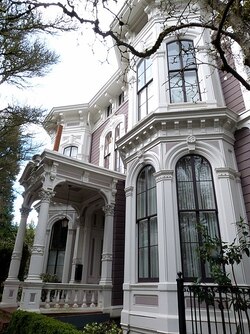
Author: Ian Poellet - Own work
|
|
Here’s the History
care of OregonLive The Fried-Durkheimer House (2177 S.W. Broadway Ave.), known also as the first Morris Marks residence, cost five times the average home when constructed in 1880 at 1134 S.W. 12th Ave., near tony Park Blocks mansions and an easy carriage ride to Washington Park. For a century, the once-regal, downtown “town house,” with ornate arches, bay windows and balconies, was a rooming house, later sharing the same tax lot with the five-story Doricourt Apartments, which was built in 1908. Decades of the elaborate townhouse being boxed in by taller structures and squatters moving in after the boarding house closed its doors worried preservationists, says Michaelson, who is a board member and past board president of the Architectural Heritage Center as well as a board member of Restore Oregon, a statewide preservation organization. Surprisingly, the interior’s floor plan, original millwork and marble fireplace were left intact. The exterior and its architectural adornments had also not been altered. Longtime owners had applied for a demolition permit but a plan to stop them from tearing it down was negotiated instead. To the rescue: Michaelson and Karlsson. In 2017, they bought the mansion for a buck. Conditions of the sale included finding and preparing a suitable lot to move it and funding about $440,000 for permits and other expenses. Oxbo Mega Transport Solutions was hired to haul two stripped-down, 84,000-pound sections of the house five blocks east and 12 blocks south to the site that was once a slice of the former Lincoln Street Reservoir, the primary source of water for much of 19th-century Portland. The Fried-Durkheimer House was relocated to 2177 S.W. Broadway Ave., an 8,800-square-foot lot, in September 2017. The design and construction team at Arciform preserved much of the original materials, which helped the 1880 Fried-Durkheimer House earn a spot on the National Register of Historic Places. Today, there is 3,900 square feet of commercial space within the two-story main building and a new lower level with a separate entrance plus eight off-street parking spaces, according to Jim Brunke of Jim Brunke Real Estate. “In the original site, we were only able to see the front of the house,” says Karlsson. “Now it shines from every direction.” |
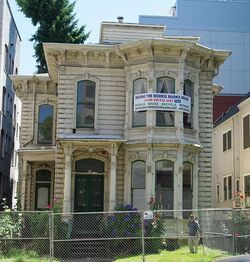
Author: M.O. Stevens
|
Edward Hochapfel House-1904- (1120 sw 11)
C.K. Henry Building-1909- (309 sw 4)
Jefferson Substation-1909 & 1925- (37 sw Jefferson)
Bank of Calif. Building-1924- 330 sw 6)
Odd Fellows Building-922- 1019 sw 10)
Elks Temple-1922- (614 sw 11)
First National Bank-1916- (401 sw 5) is considered the finest example of Twentieth-Century Roman architecture on the west coast, and was the home of the first chartered national bank west of the Rockies. It bears a strong resemblance to the Lincoln Memorial and is made of marble, steel and concrete. It features Greek Doric columns supporting a pedimented main block. Surrounding the top of the main block is a finely carved frieze. The interior has as impressive upper chamber, featuring Ionic order columns, and a Boticini marble floor, and illuminated by a broad glass roof.


